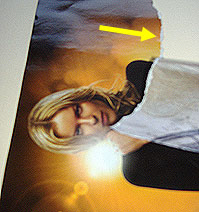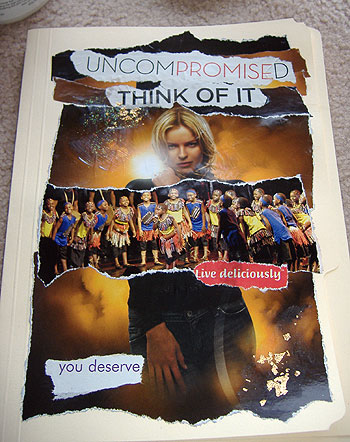Torn-paper collages are among my favorite ways to illustrate an artist’s journal.
I’ve been creating them for over 20 years now, and I never seem to get tired of them. In fact, two walls in our living room are a mini-museum of my favorite torn-paper collages. (People who visit us can be overwhelmed. It’s like they just want to stand and gawk at the art, undisturbed, for at least 20 – 30 minutes.)
Here’s how to create your own.
Steps to create a torn-paper collage
1. Gather Collage supplies.
All you really need are some pictures, something to use as glue, and something to support your collage, like a piece of paper.

More details:
For pictures, words & phrases
– Magazines, newspapers, printed materials, junk mail
I especially like fashion, travel and nature magazines for photos. “W” magazine is great for huge, almost surreal images, as well as great words & phrases. “Town & Country” magazine offers a nice mix of fashion, travel, home & garden photos, as well as yummy ads.
If I’m going to sell the finished work, I’m careful about using magazines such as National Geographic. Though their pictures are gorgeous, they have a reputation for being difficult about copyright issues.
Here’s one guideline for using otherwise-copyrighted images: Some Questions About Fair Use. They give a good example of “transformative” artwork… and that’s the kind of collage I create.
For words and phrases, I like health, fitness, religious and New Age magazines, as well as junk mail. That includes the envelopes, which are often better than whatever’s enclosed in it.
I find free magazines at public libraries and sometimes at laundromats (ask if they’re ready to get rid of some of them).
Adhesives and glues for collage art
Previously, I was using Golden Gel Medium (Soft Gel – gloss) with a sponge brush. (That’s what was in my video. I no longer recommend that as an adhesive. It makes the paper buckle and bulge unnecessarily.)

Now, I use YES! Paste. For my work, it’s absolutely perfect, with minimal buckling and puckering, and the ability to reposition the image… for at least a few minutes.
Even better, a jar seems to last forever.
When I use a sponge brush, I rinse it out completely as soon as I’m finished with it. I can usually use the same sponge brush for a week before it starts to fall apart.
When I’m applying the adhesive, I use an old phone book or junk mail underneath my work.

Support for your collage
Anything can support your collage. I generally use a regular spiral-bound sketchbook for my daily collages. However, for this one (“Uncompromised’), I used a file folder. I’m not sure why; it seemed like the right choice.
You could use poster board, canvas, wood, or almost any surface that will accept glue.
(Some dishes or tiles work well with collages, but others don’t. Test different materials and adhesives to see what works for you.)
Collage embellishments
In the past – around 2000 – I used a lot of gold leaf and glitter, but that was a personal preference. Almost anything that you can glue to a surface can be used as an embellishment.
2. Select images and words or phrases.
Go quickly through your materials, and – without much thought – choose images, words & phrases that appeal to you. Tear out the entire page and set it aside.
Tip: If you like more than one element on a page, separate them. Otherwise, it’s easy to forget that you were going to use more than one item from a single page.
I often select a word or phrase early in this process. In this case, I chose “Uncompromised” quickly. The word “promise” is in red in it, and I realized (light bulb realization) that when I compromise, I’m breaking a promise to myself or to others. Even if it’s just small and unspoken, it’s still a betrayal (big or little) of an ideal that I held or aspired to.
That’s a concept worth examining, as I work on daily priorities.
Remember that you can use a word or phrase from a sentence. I chose “you deserve” from a laxative ad!

When you feel pleased with your collection of pages, or when you have a stack of about ten pages, pause and begin working with them.
3. Tear the images in the approximate size, and then to the exact size.
If a page is really large, it can be more difficult to tear out the precise element that I want. So, I tear the page around the general area of the element, and then tear more exactly.
When I’m making the final tear, I try to tear it all in one go, not inching along, a little at a time. A smooth tear usually looks nicer, unless you have a specific reason for a very jagged edge.
Also, when you tear the magazine page, there will be a white edge in one direction of the tear. (The yellow arrow points to it.) I like to work with either all white-edged images, or keep all of my images without white edges.

4. Apply adhesive to the back of the image.
This is going to be a little messy… or even a lot messy. Revel in it!
I use a sponge brush. Some people use their fingers or a regular brush.
I keep a damp rag or paper towel next to me, to clean glue off my fingers as I work. (I also wash my brushes thoroughly, as soon as I’ve completed my work.)
Work with something underneath the image, so you can cover the back of the image with adhesive.
If the adhesive is too thick, it can be lumpy underneath the image. If the adhesive is applied in a really thin layer, it can dry too quickly. However, as long as some of it sticks to the collage, that can be enough.
If it turns out lumpy, you can use an iron (there are special irons made for this, too) — with some sort of release paper between the collage and the iron, so the iron doesn’t get all gooey from the melting medium — and the heat softens & reactivates the adhesive.
So, even dried adhesive can be reactivated and it’ll suddenly adhere the entire image to whatever’s underneath it.
I only do this when the collage is nearly completed – before I apply any glitter or gold leaf – if there’s clearly a problem where part of the collage didn’t adhere correctly.
Keep in mind that your lower layers (and at least some of their edges) will be covered by later additions to the collage. So, how they look may not matter very much.
5. Place the image where you want it to be, in your collage.
Try to place it exactly where you want it to be, or at least fairly close. If you lift, stretch, or drag a piece of magazine paper, it can stretch and look a little odd in your final work.
If your collage element seems to bubble, it’s okay to pat it flat, but don’t try to smooth it. (I learned that from collage artist Claudine Hellmuth.)
If you brush it or rub it with your fingers to smooth it, it’ll stretch the paper and the finished result might be disappointing.
Bubbled paper seems to shrink back to shape was the adhesive dries, or at least some papers will do that. So, if you’re going to put something over the bubbled piece, let the bubbled part dry, first. It might flatten out on its own.
6. Keep working. Build up more layers. Tear more images as you work, if you need more images.
I usually tear out the first three or four images that I’m going to work with, and then start building the collage.
When I’m happy with them, or if I decide to add another image that I haven’t torn out yet, I pause and tear out what I’ll need next.
If I have a massive pile of torn paper – good stuff and paper that I may (or may not) use – it can become confusing.

7. Continue to build your collage.
Remember that the first layers are the background. As you add layers, they’ll be on top. (It’s amazingly easy to forget this, sometimes.)
The focal point (or points) of your collage should probably be on top. The leading areas tend to attract the attention of the viewer.
However, it’s okay to tuck little surprises in the lower layers, for the viewer to “discover” as he or she explores the collage.
Also, don’t despair if your collage looks messy. Some will be more messy than others. It’s okay.
Here’s a close-up of one area on this morning’s collage.

… Here’s what you need to know if you make a “mistake.”
1. Milky areas will probably dry clear.
2. If the paper looks translucent in some areas (like right above the letter T in the photo above), they’ll probably turn opaque when the adhesive dries.
3. Anything that looks weird when the collage is nearly finished, can be covered with embellishments (glitter, gold leaf, threads, pieces of mica, paint, etc.) or you can cover it with another image or phrase.
It’s okay to change your mind.
For this collage, I’d selected a great image of a model looking in one direction. However, I discovered an even better photo on the back of it: Mulawi children in colorful, traditional clothing.
So, allow for serendipity as you work.
8. Keep building your collage until you’re happy with it.
It’s okay to take your time. It’s also okay to rush through this in a flurry of creativity.
You can start the collage, walk away from it, and finish it later in the day, or the next day, or the next week!
Tip: When you think to yourself, “I think this is nearly finished,” it’s probably finished. Stop! Take a break, and then take a fresh look at it.
It’s better to stop too early than take the work too far.
9. Consider adding embellishments.
I love embellishments, but you don’t have to add any at all. Every artist has his or her own style.
Embellishments can include things like:
- Glitter, tinsel, gold leaf (or copper leaf, etc.), feathers, or ribbon.
- Tissue paper (it may remain translucent if you use gel medium over and underneath that layer).
- Thread, glued on or stitched on.
- Beads, mica, sand, pieces of glass.
- Paint, oil pastels, stencils, rubber stamp art.
You can even embed something that plays a tune or says something (like in greeting cards) in your collage, for people to press.
The possibilities are unlimited.
10. (Optional) Finish with a coat of gel medium or other sealer.
After the collage is fully dry, you can seal it with a thin coat of gel medium. Well, maybe. It might make the paper buckle.
And really, it’s not necessary. I mean, yes, it will give the collage a uniform level of gloss (or a uniformly matte finish, if you used a matte gel medium).
It might also protect the collage from dust and damage, if you want to leave it “as is” instead of displaying it under glass.
Tip: If you’re using this in an artist’s journal – such as a spiral-bound sketchpad – place a piece of wax paper between the collage and the facing page. That will prevent the pages from sticking together.
My finished collage

Though I could probably explain all of the elements, it’s true that “a picture is worth a thousand words.”
Basically, this is about re-evaluating compromises… things that I decided were okay, short-term, as a step to a more important goal. For me, it’s easy for those to become long-term issues.
For me, the image of the happy children in colorful clothing is important. It’s how joyous and self-expressive we all can be.
And yes, we all deserve to live deliciously, savoring every moment!
Here’s the YouTube video in which I narrate how I make torn-paper collages. It’s only four minutes, so it’s a bit of a whirlwind. And remember: I’m now using Yes! Paste, not gel medium.
